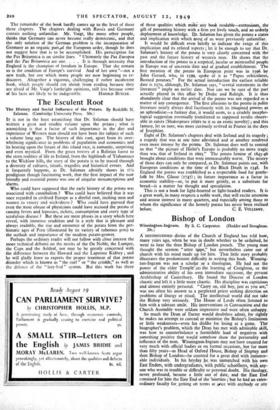The Esculent Root
The History and Social Influence of the Potato. By Redcliffe N. Salaman. (Cambridge University Press. 50s.)
IT is not in the least astonishing that Dr. Salaman should have written a great and erudite volume upon the potato ; what is astonishing is that a factor of .auch importance in the diet and experience of Western man should not have been the subject of such a volume long ago. The history of this root, apart from its over- whelming significance in problems of population and economics and its bearing upon the future of this island race, is romantic, surprising and even mystical. From the green terrors of a Bolivian forest to the stern realities of life in Ireland, from the highlands of Tiahuanaco to the Wicklow hills, the story of the potato is to be traced through a diversity of cultures, rituals, tragedies and historical events. And it frequently happens, as Dr. Salaman adroitly shows in this prodigious though fascinating work, that the first impact of the now friendly and essential potato was one of singular misconceptions and sterols.
Who could have supposed that the early history of the potato was associated with cannibalism ? Who could have believed that it was once regarded in civilised Europe as a direful root, inciting men and women to venery and wickedness ? Who could have guessed that even the most obtuse of physicians could have accused the potato of causing fevers and leprosies, rickets, consumption and every type of scrofulous disease ? But these arc mere phases in a story which here reveal, with immense erudition and in a style that is pleasant and always readable, the rise and eminence of the potato from the pre- historic ages of Peru (illustrated by its variety of tuberous pots) to the outlook and importance of the modern potato-grower.
Perhaps the ordinary reader will not follow with close interest the more technical debates on the merits of the Ox Noble, the Lumper, the Cups and the Ashleaf, nor may he be greatly concerned with the difference between the Howard and the Lapstone Kidney; and he will gladly leave to experts the proper treatment of that potato disorder which is known as "the curl" or "the crinkle," as well as the defence of the " lazy-b " system. But this work has three of those qualities which mike any book readable—enthusiasm, the gift of presenting history with a firm yet lively touch, and an orderly deployment of knowledge. Dr. Salaman has given the potato a status and implication with which most of us were previously unfamiliar.
It would be difficult even- briefly to indicate the range of this implication and its related aspects ; let it be enough to say that Dr. Salaman's history of the potato is' very closely concerned with the past and the future history of western man. He shows that the introduction of the potato to a sceptical, jocular or mistrustful people in Europe was of uncerain 'date and of gradual establishment. The first mention of the potato in European print was in 1596 by John Gerard, who, in z599, spoke of it as " Papus orbiculatus, Bastard potatoes." For the actual introduction the earliest reliable date is 1570, although, Dr. Salaman says, "several statements in the literature" imply an earlier date. Nor can we be sure of the part actually played in this affair by Drake and Raleigh. It is thus abundantly clear that the arrival of the potato was not regarded as a matter of any consequence. The first allusions to the potato in polite literature nearly always deal facetiously with its imagined powers as an aphrodisiac—a fantasy due, it would seem, to a crudely morpho- logical suggestion eventually transferred to supposed results observ- able in eaters (Shakespeare refers to it as an erotic novelty); and this fantasy, let us note, was most curiously revived in France in the days of Josephine.
Eight of Dr. Salaman's chapters deal with Ireland and its tragedy ; a tragedy that was at one time alleviated and at another rendered even more intense by the Nieto, Dr. Salaman does well to remind us that "the picture of Hitler's Europe is probably no more tragic than was that of Ireland in 1603." The potato famine of 1845-46 brought about conditions that were immeasurably worse. The misery of those days can only be compared, as Dr. Salaman points out, with European conditions at the time of the Black Death in 1348. In England the potato was established as a respectable food for gentle- folk by Mrs. Glasse (1747); its future importance as a factor in economic stability—or, to put it more grimly, as a substitute for bread—is a matter for thought and speculation.
This is not a book for light-hearted or light-headed readers. It is a great work, in many respects a noble work, that will excite attention and arouse interest in many quarters, and especially among those to whom the significance of the homely potato has never been realised






























 Previous page
Previous page